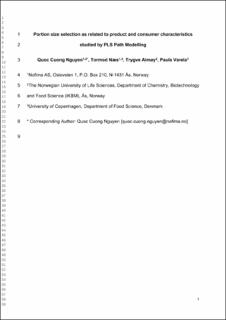Portion size selection as related to product and consumer characteristics studied by PLS path modelling.
Peer reviewed, Journal article
Submitted version
Permanent lenke
https://hdl.handle.net/11250/2826091Utgivelsesdato
2020Metadata
Vis full innførselSamlinger
Originalversjon
10.1016/j.foodqual.2018.11.020Sammendrag
Expectations of satiation and satiety have been increasingly investigated because of the interest in how they, along with liking, can modulate portion-size selection. Consumer characteristics can also be important when consumers select their portion size. However, the contribution and interaction of consumers and product aspects to portion size selection has not been unveiled. This study aims to better understanding these complex relations by simultaneously assessing the relative influence of consumer characteristics and product related properties on portion size selection utilizing PLS-Path Modelling (PLS-PM) approach. In this study, consumers (n = 101) answered questions regarding attitudes to health and hedonic characteristics of foods, and completed hunger and fullness questions. In an evaluation step, they tasted eight samples of yogurt with different textures and rated liking, expected satiation, expected satiety and portion size. The consumers were also classified on their mouth behaviour by using the JBMB™ tool. Results showed that liking, satiation, satiety and portion size depended firstly on the thickness, and then on the particle size of samples. PLS-PM was used to generate a model, indicating that liking was a direct predictor of portion size, with a stronger effect than satiation or satiety. The relationship between liking and satiety was observed both in direct direction (liking-satiety) and also indirect direction throughout satiation (liking-satiation-satiety). The former was negative effect and the latter was positive effect depending on the criteria which consumers used. These findings implied that liking is a main factor in the prediction of portion size however the relations are complex.
